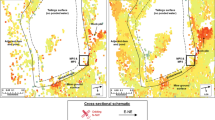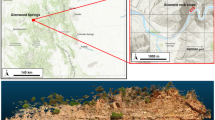Abstract
Rock landslide failure boundaries contain large amounts of rock mass structure information, providing many details that help researchers understand the causes of landslide failure. Taking the Zhaobiyan (ZBY) landslide triggered by the 2008 MS 8.0 Wenchuan earthquake as an example, we systematically introduce a workflow for analyzing the structural characteristics of landslide failure boundaries using three-dimensional point clouds. First, multi-source data of the failure boundaries are obtained via terrestrial laser scanning and unmanned aerial vehicle photography. Next, on the basis of the hue, saturation, value color reconstruction technique, and the density-based spatial clustering of applications with noise, more than 3,870,000 orientations and eight groups of joint faces are extracted from these data. Finally, the spacing, persistence, and roughness of the joint faces are calculated. According to the roughness, we determined that the north flank of the ZBY landslide is a smooth friction face resulting from tectonic shear. With increasing movement distance of the landslide on the slip surface, the roughness is increasingly controlled by landslide slickensides instead of the structure. Furthermore, we confirmed that both sides of the ZBY landslide are primarily controlled by planar shearing failure with the linkage of Joints J1 and J2, which are located on the north and south flanks, respectively. The damaged areas on the two flanks caused by shear failure reached 86.53% and 73.02%, respectively, of the flank areas. The main scarp is composed of wedge failures at different scales, and the area damaged by tension reached 89.28% of the main scarp area.

(Modified from Cui et al. (2018)). The F5 fault is the middle segment of the causative fault (YX-BC) of the 2008 Wenchuan earthquake. The ZBY landslide occurred in the block located between F3 and F4 faults, and the site is the southeastern limb of the S1 anticline




















Similar content being viewed by others
Data availability
The datasets generated during and/or analysed during the current study are available from the corresponding author on reasonable request.
References
Albarelli D, Mavrouli OC, Nyktas P (2021) Identification of potential rockfall sources using UAV-derived point cloud. Bull Eng Geol Environ 80(8):6539–6561. https://doi.org/10.1007/s10064-021-02306-2
Barton N, Choubey V (1977) The shear strength of rock joints in theory and practice. Rock Mech 10(1):1–54. https://doi.org/10.1007/BF01261801
Bordehore LJ, Riquelme A, Cano M, Roberto T (2017) Comparing manual and remote sensing field discontinuity collection used in kinematic stability assessment of failed rock slopes. Int J Rock Mech Min 97:24–32. https://doi.org/10.1016/j.ijrmms.2017.06.004
Boulch A, Marlet R (2012) Fast and robust normal estimation for point clouds with sharp features. Comput Graph Forum 31(5):1765–1774. https://doi.org/10.1111/j.1467-8659.2012.03181.x
Brideau MA, Sturzenegger M, Stead D, Jaboyedoff M, Lawrence M, Roberts N et al (2012) Stability analysis of the 2007 Chehalis lake landslide based on long-range terrestrial photogrammetry and airborne LiDAR data. Landslides 9(1):75–91. https://doi.org/10.1007/s10346-011-0286-4
Brideau MA, Yan M, Stead D (2009) The role of tectonic damage and brittle rock fracture in the development of large rock slope failures. Geomorphology 103(1):30–49. https://doi.org/10.1016/j.geomorph.2008.04.010
Chen J, Zhu H, Li X (2016) Automatic extraction of discontinuity orientation from rock mass surface 3D point cloud. Comput Geosci 95:18–31. https://doi.org/10.1016/j.cageo.2016.06.015
Chen N, Kemeny J, Jiang QH, Pan ZW (2017) Automatic extraction of blocks from 3D point clouds of fractured rock. Comput Geosci 109:149–161. https://doi.org/10.1016/j.cageo.2017.08.013
Corradetti A, McCaffrey K, De Paola N, Tavani S (2017) Evaluating roughness scaling properties of natural active fault surfaces by means of multi-view photogrammetry. Tectonophysics 717:599–606. https://doi.org/10.1016/j.tecto.2017.08.023
Cui S, Pei X, Huang R (2018) Effects of geological and tectonic characteristics on the earthquake-triggered Daguangbao landslide. China Landslides 15(4):649–667. https://doi.org/10.1007/s10346-017-0899-3
Cui S, Pei X, Jiang Y, Wang G, Fan X, Yang Q, Huang R (2021) Liquefaction within a bedding fault: understanding the initiation and movement of the Daguangbao landslide triggered by the 2008 Wenchuan Earthquake (Ms= 8.0). Eng Geol 295:106455. https://doi.org/10.1016/j.enggeo.2021.106455
Cui S, Wu H, Pei X, Yang Q, Huang R, Guo B (2022) Characterizing the spatial distribution, frequency, geomorphological and geological controls on landslides triggered by the 1933 Mw 7.3 Diexi Earthquake, Sichuan, China. Geomorphology 403:108177. https://doi.org/10.1016/j.geomorph.2022.108177
Cui S, Yang Q, Pei X, Huang R, Guo B, Zhang W (2020) Geological and morphological study of the Daguangbao landslide triggered by the Ms. 8.0 Wenchuan earthquake, China. Geomorphology 370(1):107394. https://doi.org/10.1016/j.geomorph.2020.107394
Dershowitz WS, Einstein HH (1988) Characterizing rock joint geometry with joint system models. J Rock Mech Rock Eng 21(1):21–51. https://doi.org/10.1007/BF01019674
Dong X (2015) Research of comprehensive application of three-dimensional image technology in geologic engineering. Chengdu University of Technology (in Chinese).
Dong X, Xu Q, Huang R, Liu Q, Kieffer D (2020) Reconstruction of surficial rock blocks by means of rock structure modelling of 3D TLS point clouds: the 2013 Long-Chang Rockfall. Rock Mech Rock Eng 53(2):671–689. https://doi.org/10.1007/s00603-019-01935-0
Ester M, Kriegel HP, Sander J, Xu X (1996) A density-based algorithm for discovering clusters in large spatial databases with noise. KDD, pp. 226–231.
Feng Q, Röshoff K (2015) A survey of 3D laser scanning techniques for application to rock mechanics and rock engineering. The ISRM suggested methods for rock characterization, testing and monitoring: 2007–2014. Springer International Publishing, pp. 265–293.
Ganerød GV, Grøneng G, Rønning JS, Dalsegg E, Elvebakk H, Tønnesen JF, Kveldsvik V, Eiken T, Blikra LH, Bra-athen A (2008) Geological model of the Åknes rockslide, western Norway. Eng Geol 102(1–2):1–18. https://doi.org/10.1016/j.enggeo.2008.01.018
Garcia Luna R, Senent S, Jimenez R (2021) Using telephoto lens to characterize rock surface roughness in SfM models. Rock Mech Rock Eng 54(5):2369–2382. https://doi.org/10.1007/s00603-021-02373-7
Ge Y, Lin Z, Tang H, Zhong P, Cao B (2020) Measurement of particle size of loose accumulation based on alpha sh-apes (AS) and hill climbing-region growing (HC-RG) algorithms. Sensors 20(3):883. https://doi.org/10.3390/s20030883
Gigli G, Frodella W, Garfagnoli F, Morelli S, Mugnai F, Menna F, Casagli N (2014) 3-D geomechanical rock mass characterization for the evaluation of rockslide susceptibility scenarios. Landslides 11(1):131–140. https://doi.org/10.1007/s10346-013-0424-2
Goodman RE (1989) Introduction to rock mechanics, 2nd edn. Wiley, New York
Huang RQ (2009) Mechanism and geomechanical models of landslide hazards triggered by Wenchuan 8.0 Earthquake. Chin J Rock Mech Eng 28:1239–1249 ((in Chinese))
ISRM (1978) Suggested methods for the quantitative description of discontinuities in rock masses. Int J Mech Min Sci Geomech Abstr 15:319–368
Jaboyedoff M, Couture R, Locat P (2009) Structural analysis of Turtle Mountain (Alberta) using digital elevation model: toward a progressive failure. Geomorphology 103(1):5–16. https://doi.org/10.1016/j.geomorph.2008.04.012
Kong D, Wu F, Saroglou C (2020) Automatic identification and characterization of discontinuities in rock masses from 3D point clouds. Eng Geol 265:105442. https://doi.org/10.1016/j.enggeo.2019.105442
Li H, Huang R (2014) Method of quantitative determination of joint roughness coefficient. Chin J Rock Mech Eng 33(s2):3489–3497 (in Chinese). https://doi.org/10.13722/j.cnki.jrme.2014.s2.012
Li H, Li X, Ning Y, Jiang S, Zhou J (2019a) Dynamical process of the Hongshiyan landslide induced by the 2014 Ludian earthquake and stability evaluation of the back scarp of the remnant slope. Bull Eng Geol Environ 78(3):2081–2092. https://doi.org/10.1007/s10064-018-1233-6
Li X, Chen Z, Chen J, Zhu H (2019b) Automatic characterization of rock mass discontinuities using 3D point clouds. Eng Geol 259:105131. https://doi.org/10.1016/j.enggeo.2019.05.008
Liang J, Cui S, Pei X, Huang R (2021) Initiation mechanism of earthquake-induced large landslides considering structural damage. Chin J Geot Eng 43(06):1039–1049 ((in Chinese))
Oppikofer T, Jaboyedoff M, Pedrazzini A, Derron MH, Blikra LH (2011) Detailed DEM analysis of a rockslide scar to characterize the basal sliding surface of active rockslides. J Geophys Res 116. https://doi.org/10.1029/2010JF001807
Priest SD, Hudson JA (1976) Discontinuity spacings in rocks. Int J Rock Mech Min Sci Geomech Abstr 13(5):135–148
Riquelme AJ, Abellán A, Tomás R (2015) Discontinuity spacing analysis in rock masses using 3D point clouds. Eng Geol 195:185–195. https://doi.org/10.1016/j.enggeo.2015.06.009
Riquelme AJ, Abellán A, Tomás R, Jaboyedoff M (2014) A new approach for semi-automatic rock mass joints recognition from 3D point clouds. Comput Geosci 68:38–52. https://doi.org/10.1016/j.cageo.2014.03.014
Riquelme AJ, Tomás R, Cano M, Pastor JL, Abellán A (2018) Automatic mapping of discontinuity persistence on rock masses using 3D point clouds. Rock Mech Rock Eng 51:3005–3028. https://doi.org/10.1007/s00603-018-1519-9
Spreafico MC, Francioni M, Cervi F, Stead D, Bitelli G, Ghirotti M, Girelli VA, Lucente CC, Tini MA, Borgatti L (2016) Back analysis of the 2014 San Leo landslide using combined terrestrial laser scanning and 3D distinct element modelling. Rock Mech Rock Eng 49(6):2235–2251. https://doi.org/10.1007/s00603-015-0763-5
Tonini M, Abellan A (2014) Rockfall detection from terrestrial LiDAR point clouds: a clustering approach using R. J Spat Inf Sci 8:95–110. https://doi.org/10.5311/JOSIS.2014.8.123
Wolter A, Stead D, Clague JJ (2014) A morphologic characterisation of the 1963 Vajont Slide, Italy, using long-range terrestrial photogrammetry. Geomorphology 206:147–164. https://doi.org/10.1016/j.geomorph.2013.10.006
Wu H, Zheng D, Zhang Y, Dong Li, Ting N (2020) A photogrammetric method for laboratory-scale investigation on 3D landslide dam topography. Bull Eng Geol Environ 79(9):4717–4732. https://doi.org/10.1007/s10064-020-01870-3
Xia YJ, Zhang CQ, Zhou H, Chen JL, Gao Y, Liu N, Chen PZ (2020) Structural characteristics of columnar jointed basalt in drainage tunnel of Baihetan hydropower station and its influence on the behavior of P-wave anisotropy. Eng Geol 264:105304. https://doi.org/10.1016/j.enggeo.2019.105304
Yin Y, Wang M, Li B, Feng Z (2012) Dynamic response characteristics of Daguangbao landslide triggered by Wenchuan earthquake. Chin J Rock Mech Eng 31(10):1969–1982 ((in Chinese))
Zhang ZY, Wang ST, Wang LS (2009) Principle of engineering geology analysis. Geological Publishing House Press, Beijing, 6–36 (in Chinese)
Acknowledgements
Special appreciation goes to the editor and two anonymous reviewers of this manuscript for their time and valuable comments.
Funding
This study was supported by the National Natural Science Foundation of China (Grants No . 41931296) and Sichuan Science and Technology Program (Grants Nos. 2022NSFSC1121 and 2022NSFSC1053).
Author information
Authors and Affiliations
Contributions
Shenghua Cui: conceptualization, investigation, resources, writing – review and editing, supervision. Yufei Liang: methodology, software, formal analysis, investigation, writing – original draft. Xiangjun Pei: project administration, funding acquisition, supervision. Luguang Luo: data curation, methodology. Qingwen Yang: conceptualization, visualization. Ling Zhu: investigation, writing – review and editing.
Corresponding author
Rights and permissions
Springer Nature or its licensor (e.g. a society or other partner) holds exclusive rights to this article under a publishing agreement with the author(s) or other rightsholder(s); author self-archiving of the accepted manuscript version of this article is solely governed by the terms of such publishing agreement and applicable law.
About this article
Cite this article
Cui, S., Liang, Y., Pei, X. et al. Structural characteristics of landslide failure boundaries using three-dimensional point clouds: a case study of the Zhaobiyan landslide, China. Bull Eng Geol Environ 82, 127 (2023). https://doi.org/10.1007/s10064-023-03140-4
Received:
Accepted:
Published:
DOI: https://doi.org/10.1007/s10064-023-03140-4




